Financial Performance Management (Online Exam) Solution
VerifiedAdded on 2022/12/28
|14
|2876
|1
Homework Assignment
AI Summary
This document presents a comprehensive solution to a Financial Performance Management online exam. The solution begins with calculations based on labor costs, followed by a computation of cost per unit using an activity-based costing (ABC) approach, and a comparison of the two techniques. It also includes a discussion of sensitivity analysis and its role in helping managers deal with uncertainties. The second part of the solution involves the calculation of variances for the last month, along with a discussion of the problems with the current system of calculating and reporting variances for assessing the performance of the production manager. Finally, the document contrasts Zero-Based Budgeting (ZBB) and Incremental Budgeting (IB), highlighting their differences in application, cost analysis, and primary focus.
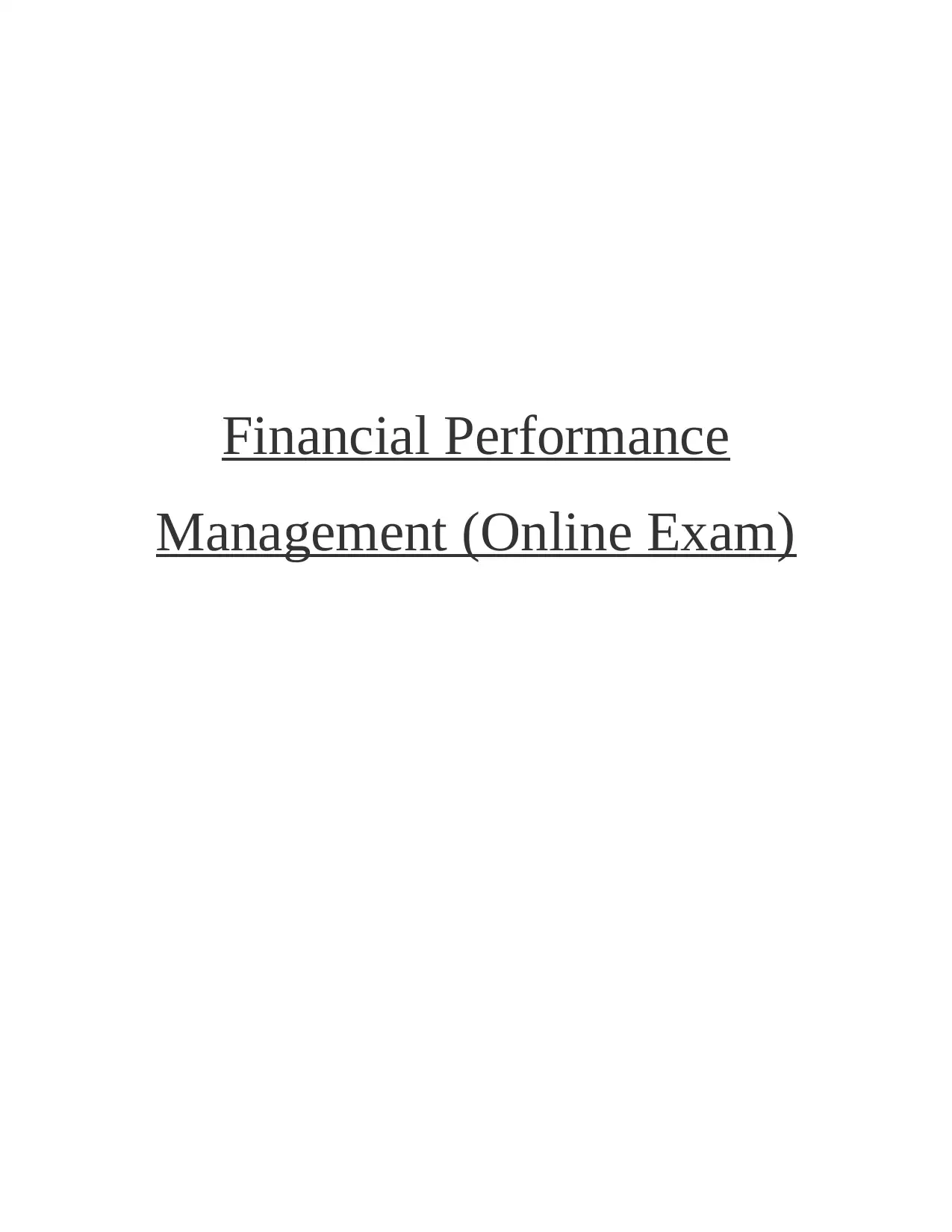
Financial Performance
Management (Online Exam)
Management (Online Exam)
Paraphrase This Document
Need a fresh take? Get an instant paraphrase of this document with our AI Paraphraser

TABLE OF CONTENTS
QUESTION 1..................................................................................................................................3
a) Calculation on the basis of labour cost ...................................................................................3
b) Computation of cost per unit on the basis of activity based costing approach........................4
c) Evaluation of better technique.................................................................................................5
d) Discussion of sensitivity analysis that helps managers to cooperate with uncertainties.........6
QUESTION 2...................................................................................................................................6
(a) calculation of variances for the last month.............................................................................6
(b) Discuss the problems with the current system of calculating and reporting variances .........8
for assessing the performance of the production manager...........................................................8
QUESTION 3...................................................................................................................................9
Zero-Based Budgeting (ZBB) and Incremental Budgeting (IB) are quite different from each
other.............................................................................................................................................9
REFERENCES..............................................................................................................................11
QUESTION 1..................................................................................................................................3
a) Calculation on the basis of labour cost ...................................................................................3
b) Computation of cost per unit on the basis of activity based costing approach........................4
c) Evaluation of better technique.................................................................................................5
d) Discussion of sensitivity analysis that helps managers to cooperate with uncertainties.........6
QUESTION 2...................................................................................................................................6
(a) calculation of variances for the last month.............................................................................6
(b) Discuss the problems with the current system of calculating and reporting variances .........8
for assessing the performance of the production manager...........................................................8
QUESTION 3...................................................................................................................................9
Zero-Based Budgeting (ZBB) and Incremental Budgeting (IB) are quite different from each
other.............................................................................................................................................9
REFERENCES..............................................................................................................................11
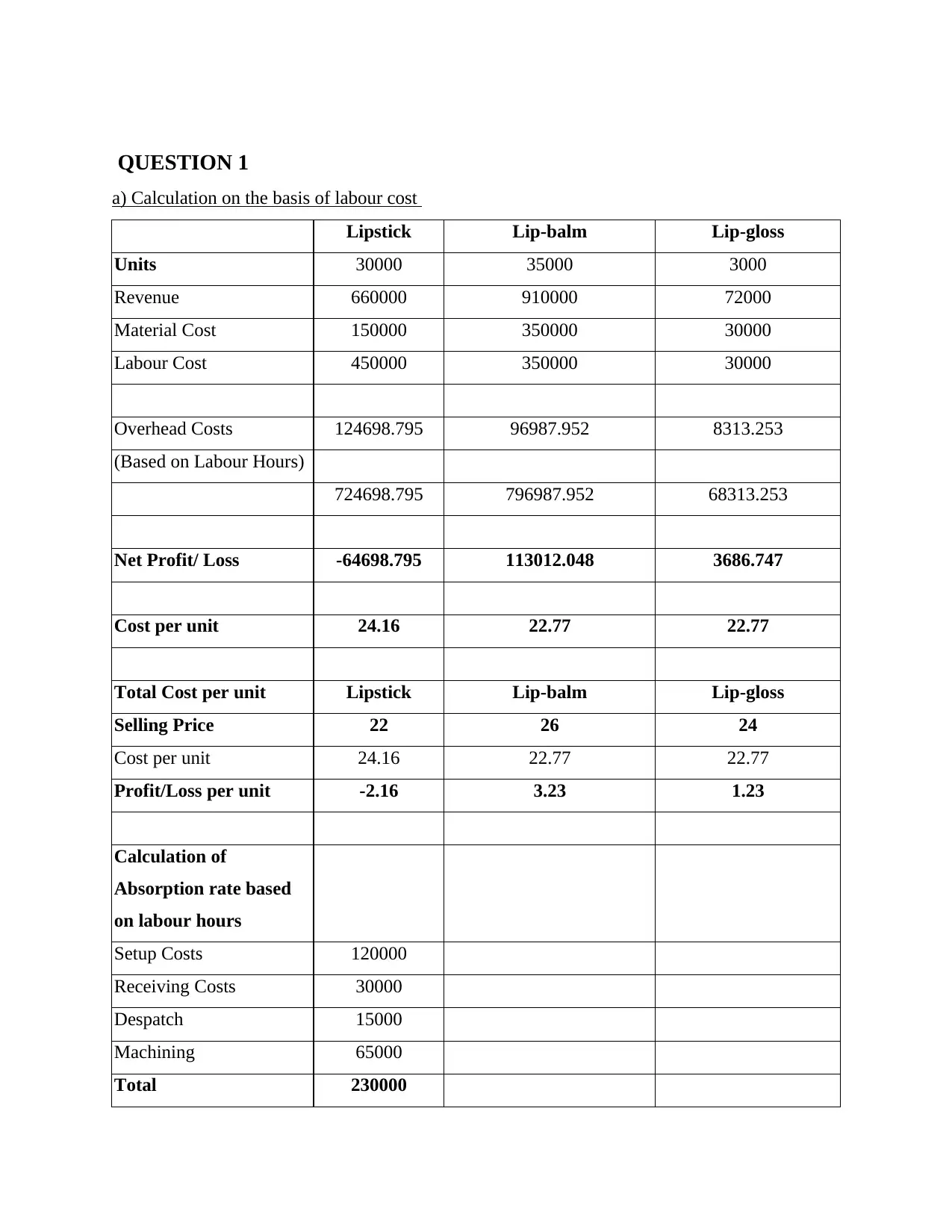
QUESTION 1
a) Calculation on the basis of labour cost
Lipstick Lip-balm Lip-gloss
Units 30000 35000 3000
Revenue 660000 910000 72000
Material Cost 150000 350000 30000
Labour Cost 450000 350000 30000
Overhead Costs 124698.795 96987.952 8313.253
(Based on Labour Hours)
724698.795 796987.952 68313.253
Net Profit/ Loss -64698.795 113012.048 3686.747
Cost per unit 24.16 22.77 22.77
Total Cost per unit Lipstick Lip-balm Lip-gloss
Selling Price 22 26 24
Cost per unit 24.16 22.77 22.77
Profit/Loss per unit -2.16 3.23 1.23
Calculation of
Absorption rate based
on labour hours
Setup Costs 120000
Receiving Costs 30000
Despatch 15000
Machining 65000
Total 230000
a) Calculation on the basis of labour cost
Lipstick Lip-balm Lip-gloss
Units 30000 35000 3000
Revenue 660000 910000 72000
Material Cost 150000 350000 30000
Labour Cost 450000 350000 30000
Overhead Costs 124698.795 96987.952 8313.253
(Based on Labour Hours)
724698.795 796987.952 68313.253
Net Profit/ Loss -64698.795 113012.048 3686.747
Cost per unit 24.16 22.77 22.77
Total Cost per unit Lipstick Lip-balm Lip-gloss
Selling Price 22 26 24
Cost per unit 24.16 22.77 22.77
Profit/Loss per unit -2.16 3.23 1.23
Calculation of
Absorption rate based
on labour hours
Setup Costs 120000
Receiving Costs 30000
Despatch 15000
Machining 65000
Total 230000
⊘ This is a preview!⊘
Do you want full access?
Subscribe today to unlock all pages.

Trusted by 1+ million students worldwide
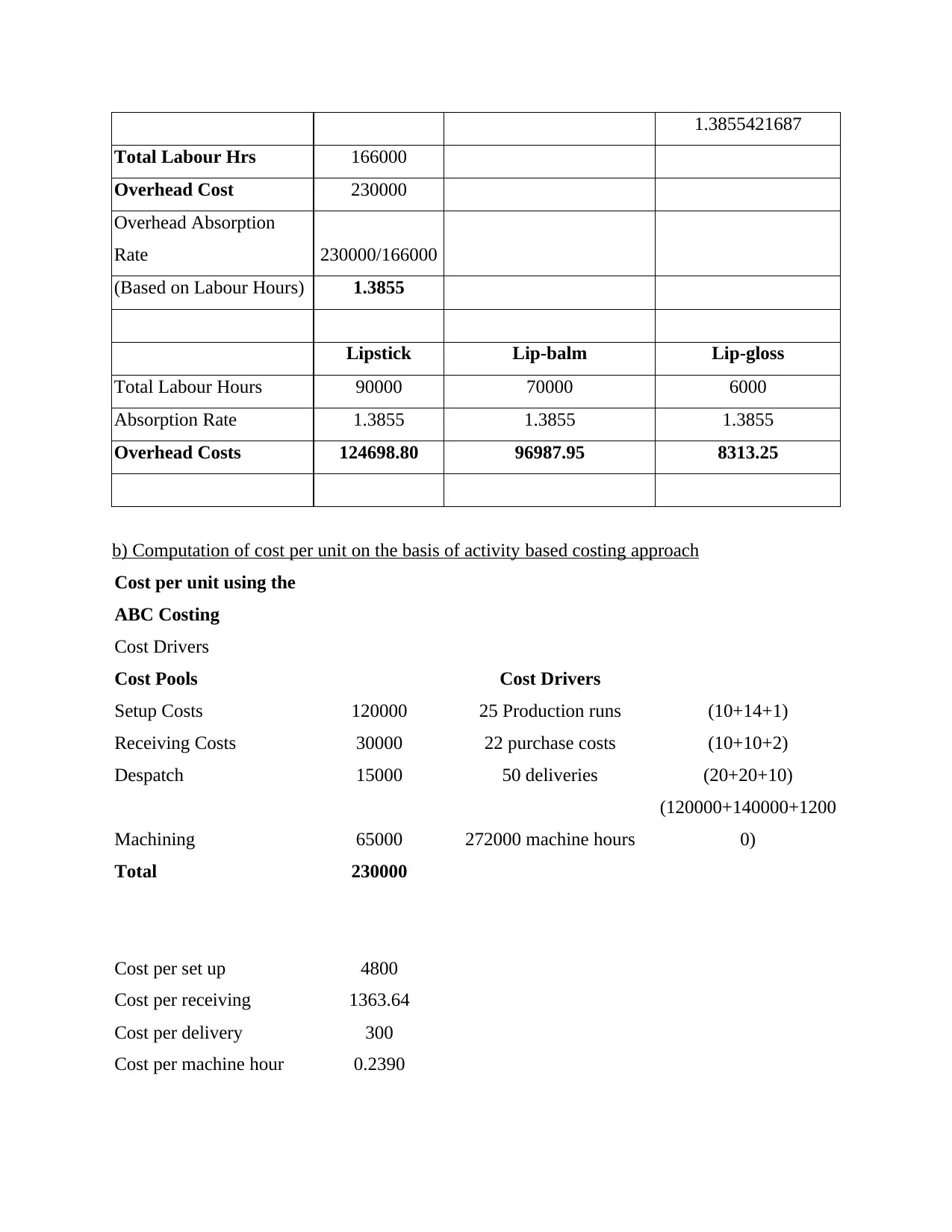
1.3855421687
Total Labour Hrs 166000
Overhead Cost 230000
Overhead Absorption
Rate 230000/166000
(Based on Labour Hours) 1.3855
Lipstick Lip-balm Lip-gloss
Total Labour Hours 90000 70000 6000
Absorption Rate 1.3855 1.3855 1.3855
Overhead Costs 124698.80 96987.95 8313.25
b) Computation of cost per unit on the basis of activity based costing approach
Cost per unit using the
ABC Costing
Cost Drivers
Cost Pools Cost Drivers
Setup Costs 120000 25 Production runs (10+14+1)
Receiving Costs 30000 22 purchase costs (10+10+2)
Despatch 15000 50 deliveries (20+20+10)
Machining 65000 272000 machine hours
(120000+140000+1200
0)
Total 230000
Cost per set up 4800
Cost per receiving 1363.64
Cost per delivery 300
Cost per machine hour 0.2390
Total Labour Hrs 166000
Overhead Cost 230000
Overhead Absorption
Rate 230000/166000
(Based on Labour Hours) 1.3855
Lipstick Lip-balm Lip-gloss
Total Labour Hours 90000 70000 6000
Absorption Rate 1.3855 1.3855 1.3855
Overhead Costs 124698.80 96987.95 8313.25
b) Computation of cost per unit on the basis of activity based costing approach
Cost per unit using the
ABC Costing
Cost Drivers
Cost Pools Cost Drivers
Setup Costs 120000 25 Production runs (10+14+1)
Receiving Costs 30000 22 purchase costs (10+10+2)
Despatch 15000 50 deliveries (20+20+10)
Machining 65000 272000 machine hours
(120000+140000+1200
0)
Total 230000
Cost per set up 4800
Cost per receiving 1363.64
Cost per delivery 300
Cost per machine hour 0.2390
Paraphrase This Document
Need a fresh take? Get an instant paraphrase of this document with our AI Paraphraser

Allocation of overheads
to each product
Lipstick Lip-balm Lip-gloss
products 30000 35000 3000
Setup Costs 48000 67200 4800
Receiving Costs 13636.36 13636.36 2727.27
Despatch 6000 6000 3000
Machining 28676.47 33455.88 2867.65
Total 96312.83 120292.25 13394.92
Overhead Cost per
product 3.210 3.437 4.465
Total Cost per unit Lipstick Lip-balm Lip-gloss
Material Cost 5 10 10
Labour Cost 15 10 10
Overheads 3.210 3.437 4.465
Cost 23.21 23.44 24.46
Total Cost per unit Lipstick Lip-balm Lip-gloss
Selling Price (SP) 22 26 24
Material Cost 5 10 10
Labour Cost 15 10 10
Overheads 3.210 3.437 4.465
Profit/Loss per unit -1.210 2.563 -0.465
to each product
Lipstick Lip-balm Lip-gloss
products 30000 35000 3000
Setup Costs 48000 67200 4800
Receiving Costs 13636.36 13636.36 2727.27
Despatch 6000 6000 3000
Machining 28676.47 33455.88 2867.65
Total 96312.83 120292.25 13394.92
Overhead Cost per
product 3.210 3.437 4.465
Total Cost per unit Lipstick Lip-balm Lip-gloss
Material Cost 5 10 10
Labour Cost 15 10 10
Overheads 3.210 3.437 4.465
Cost 23.21 23.44 24.46
Total Cost per unit Lipstick Lip-balm Lip-gloss
Selling Price (SP) 22 26 24
Material Cost 5 10 10
Labour Cost 15 10 10
Overheads 3.210 3.437 4.465
Profit/Loss per unit -1.210 2.563 -0.465
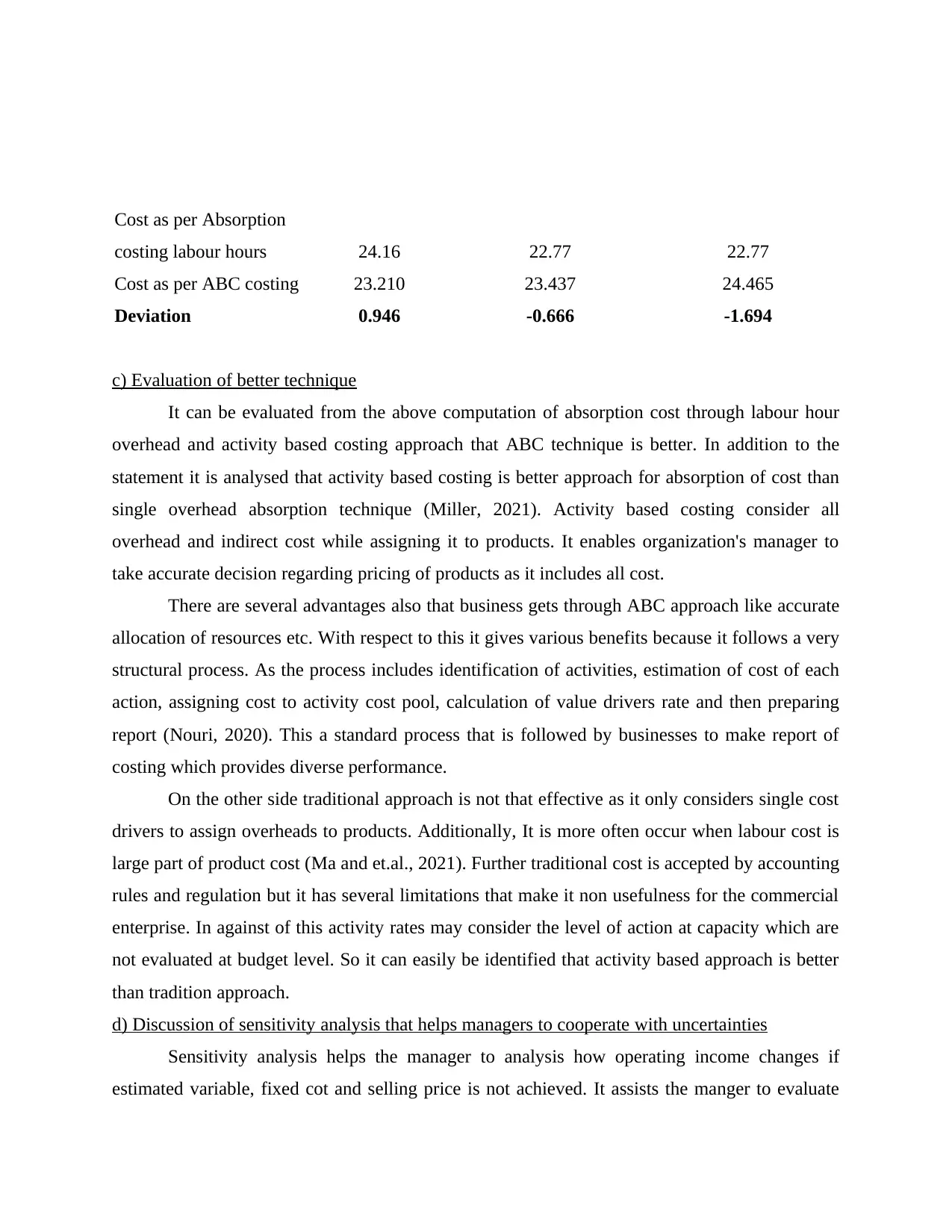
Cost as per Absorption
costing labour hours 24.16 22.77 22.77
Cost as per ABC costing 23.210 23.437 24.465
Deviation 0.946 -0.666 -1.694
c) Evaluation of better technique
It can be evaluated from the above computation of absorption cost through labour hour
overhead and activity based costing approach that ABC technique is better. In addition to the
statement it is analysed that activity based costing is better approach for absorption of cost than
single overhead absorption technique (Miller, 2021). Activity based costing consider all
overhead and indirect cost while assigning it to products. It enables organization's manager to
take accurate decision regarding pricing of products as it includes all cost.
There are several advantages also that business gets through ABC approach like accurate
allocation of resources etc. With respect to this it gives various benefits because it follows a very
structural process. As the process includes identification of activities, estimation of cost of each
action, assigning cost to activity cost pool, calculation of value drivers rate and then preparing
report (Nouri, 2020). This a standard process that is followed by businesses to make report of
costing which provides diverse performance.
On the other side traditional approach is not that effective as it only considers single cost
drivers to assign overheads to products. Additionally, It is more often occur when labour cost is
large part of product cost (Ma and et.al., 2021). Further traditional cost is accepted by accounting
rules and regulation but it has several limitations that make it non usefulness for the commercial
enterprise. In against of this activity rates may consider the level of action at capacity which are
not evaluated at budget level. So it can easily be identified that activity based approach is better
than tradition approach.
d) Discussion of sensitivity analysis that helps managers to cooperate with uncertainties
Sensitivity analysis helps the manager to analysis how operating income changes if
estimated variable, fixed cot and selling price is not achieved. It assists the manger to evaluate
costing labour hours 24.16 22.77 22.77
Cost as per ABC costing 23.210 23.437 24.465
Deviation 0.946 -0.666 -1.694
c) Evaluation of better technique
It can be evaluated from the above computation of absorption cost through labour hour
overhead and activity based costing approach that ABC technique is better. In addition to the
statement it is analysed that activity based costing is better approach for absorption of cost than
single overhead absorption technique (Miller, 2021). Activity based costing consider all
overhead and indirect cost while assigning it to products. It enables organization's manager to
take accurate decision regarding pricing of products as it includes all cost.
There are several advantages also that business gets through ABC approach like accurate
allocation of resources etc. With respect to this it gives various benefits because it follows a very
structural process. As the process includes identification of activities, estimation of cost of each
action, assigning cost to activity cost pool, calculation of value drivers rate and then preparing
report (Nouri, 2020). This a standard process that is followed by businesses to make report of
costing which provides diverse performance.
On the other side traditional approach is not that effective as it only considers single cost
drivers to assign overheads to products. Additionally, It is more often occur when labour cost is
large part of product cost (Ma and et.al., 2021). Further traditional cost is accepted by accounting
rules and regulation but it has several limitations that make it non usefulness for the commercial
enterprise. In against of this activity rates may consider the level of action at capacity which are
not evaluated at budget level. So it can easily be identified that activity based approach is better
than tradition approach.
d) Discussion of sensitivity analysis that helps managers to cooperate with uncertainties
Sensitivity analysis helps the manager to analysis how operating income changes if
estimated variable, fixed cot and selling price is not achieved. It assists the manger to evaluate
⊘ This is a preview!⊘
Do you want full access?
Subscribe today to unlock all pages.

Trusted by 1+ million students worldwide
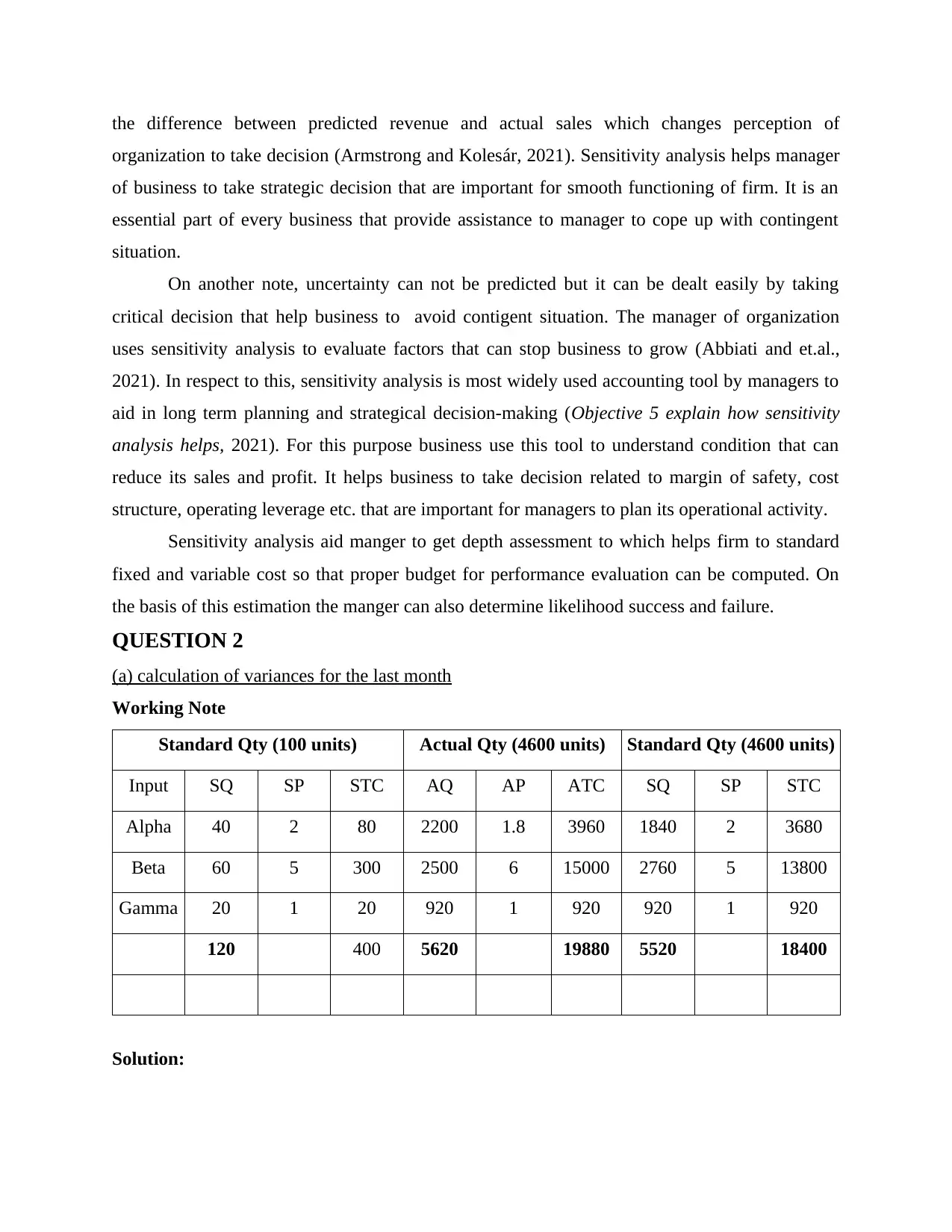
the difference between predicted revenue and actual sales which changes perception of
organization to take decision (Armstrong and Kolesár, 2021). Sensitivity analysis helps manager
of business to take strategic decision that are important for smooth functioning of firm. It is an
essential part of every business that provide assistance to manager to cope up with contingent
situation.
On another note, uncertainty can not be predicted but it can be dealt easily by taking
critical decision that help business to avoid contigent situation. The manager of organization
uses sensitivity analysis to evaluate factors that can stop business to grow (Abbiati and et.al.,
2021). In respect to this, sensitivity analysis is most widely used accounting tool by managers to
aid in long term planning and strategical decision-making (Objective 5 explain how sensitivity
analysis helps, 2021). For this purpose business use this tool to understand condition that can
reduce its sales and profit. It helps business to take decision related to margin of safety, cost
structure, operating leverage etc. that are important for managers to plan its operational activity.
Sensitivity analysis aid manger to get depth assessment to which helps firm to standard
fixed and variable cost so that proper budget for performance evaluation can be computed. On
the basis of this estimation the manger can also determine likelihood success and failure.
QUESTION 2
(a) calculation of variances for the last month
Working Note
Standard Qty (100 units) Actual Qty (4600 units) Standard Qty (4600 units)
Input SQ SP STC AQ AP ATC SQ SP STC
Alpha 40 2 80 2200 1.8 3960 1840 2 3680
Beta 60 5 300 2500 6 15000 2760 5 13800
Gamma 20 1 20 920 1 920 920 1 920
120 400 5620 19880 5520 18400
Solution:
organization to take decision (Armstrong and Kolesár, 2021). Sensitivity analysis helps manager
of business to take strategic decision that are important for smooth functioning of firm. It is an
essential part of every business that provide assistance to manager to cope up with contingent
situation.
On another note, uncertainty can not be predicted but it can be dealt easily by taking
critical decision that help business to avoid contigent situation. The manager of organization
uses sensitivity analysis to evaluate factors that can stop business to grow (Abbiati and et.al.,
2021). In respect to this, sensitivity analysis is most widely used accounting tool by managers to
aid in long term planning and strategical decision-making (Objective 5 explain how sensitivity
analysis helps, 2021). For this purpose business use this tool to understand condition that can
reduce its sales and profit. It helps business to take decision related to margin of safety, cost
structure, operating leverage etc. that are important for managers to plan its operational activity.
Sensitivity analysis aid manger to get depth assessment to which helps firm to standard
fixed and variable cost so that proper budget for performance evaluation can be computed. On
the basis of this estimation the manger can also determine likelihood success and failure.
QUESTION 2
(a) calculation of variances for the last month
Working Note
Standard Qty (100 units) Actual Qty (4600 units) Standard Qty (4600 units)
Input SQ SP STC AQ AP ATC SQ SP STC
Alpha 40 2 80 2200 1.8 3960 1840 2 3680
Beta 60 5 300 2500 6 15000 2760 5 13800
Gamma 20 1 20 920 1 920 920 1 920
120 400 5620 19880 5520 18400
Solution:
Paraphrase This Document
Need a fresh take? Get an instant paraphrase of this document with our AI Paraphraser
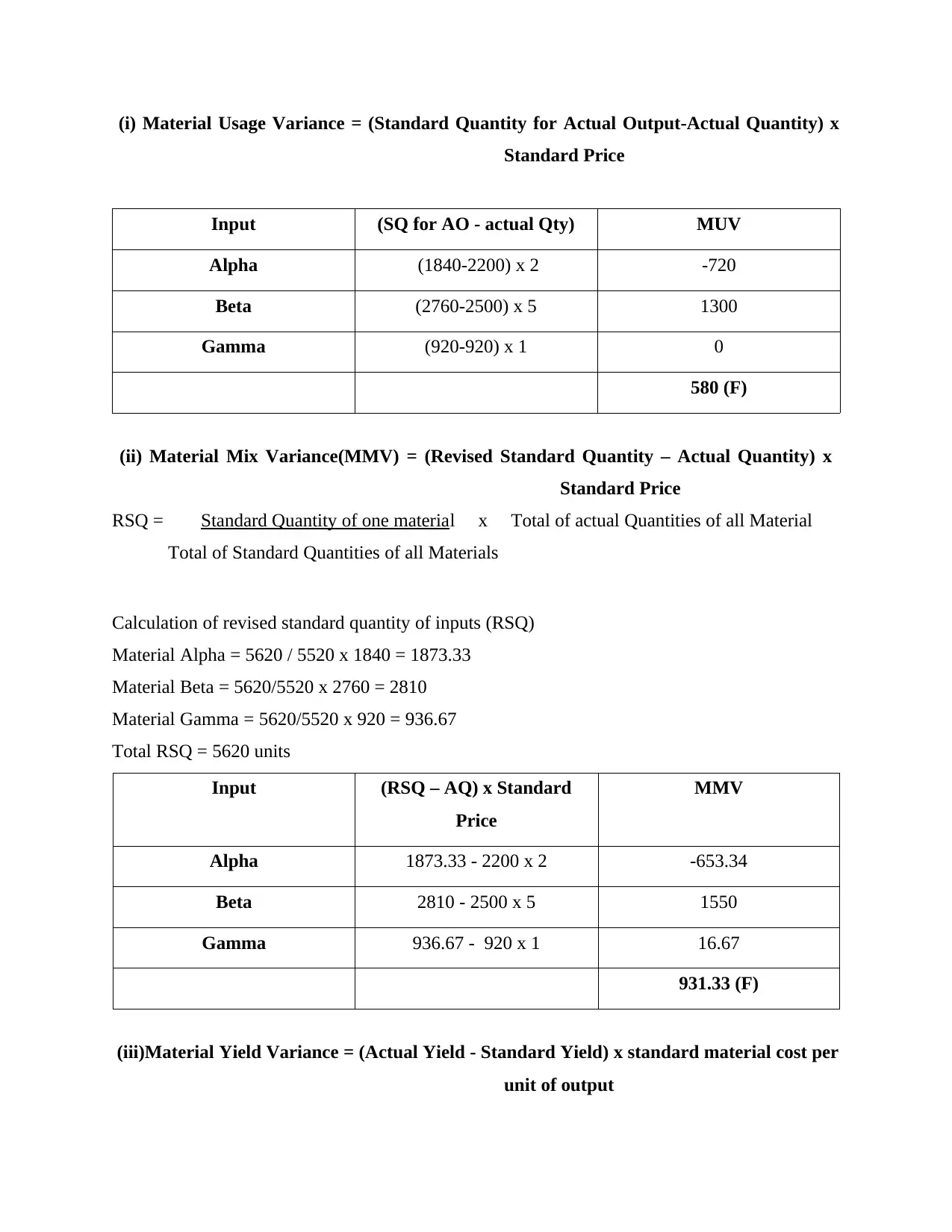
(i) Material Usage Variance = (Standard Quantity for Actual Output-Actual Quantity) x
Standard Price
Input (SQ for AO - actual Qty) MUV
Alpha (1840-2200) x 2 -720
Beta (2760-2500) x 5 1300
Gamma (920-920) x 1 0
580 (F)
(ii) Material Mix Variance(MMV) = (Revised Standard Quantity – Actual Quantity) x
Standard Price
RSQ = Standard Quantity of one material x Total of actual Quantities of all Material
Total of Standard Quantities of all Materials
Calculation of revised standard quantity of inputs (RSQ)
Material Alpha = 5620 / 5520 x 1840 = 1873.33
Material Beta = 5620/5520 x 2760 = 2810
Material Gamma = 5620/5520 x 920 = 936.67
Total RSQ = 5620 units
Input (RSQ – AQ) x Standard
Price
MMV
Alpha 1873.33 - 2200 x 2 -653.34
Beta 2810 - 2500 x 5 1550
Gamma 936.67 - 920 x 1 16.67
931.33 (F)
(iii)Material Yield Variance = (Actual Yield - Standard Yield) x standard material cost per
unit of output
Standard Price
Input (SQ for AO - actual Qty) MUV
Alpha (1840-2200) x 2 -720
Beta (2760-2500) x 5 1300
Gamma (920-920) x 1 0
580 (F)
(ii) Material Mix Variance(MMV) = (Revised Standard Quantity – Actual Quantity) x
Standard Price
RSQ = Standard Quantity of one material x Total of actual Quantities of all Material
Total of Standard Quantities of all Materials
Calculation of revised standard quantity of inputs (RSQ)
Material Alpha = 5620 / 5520 x 1840 = 1873.33
Material Beta = 5620/5520 x 2760 = 2810
Material Gamma = 5620/5520 x 920 = 936.67
Total RSQ = 5620 units
Input (RSQ – AQ) x Standard
Price
MMV
Alpha 1873.33 - 2200 x 2 -653.34
Beta 2810 - 2500 x 5 1550
Gamma 936.67 - 920 x 1 16.67
931.33 (F)
(iii)Material Yield Variance = (Actual Yield - Standard Yield) x standard material cost per
unit of output
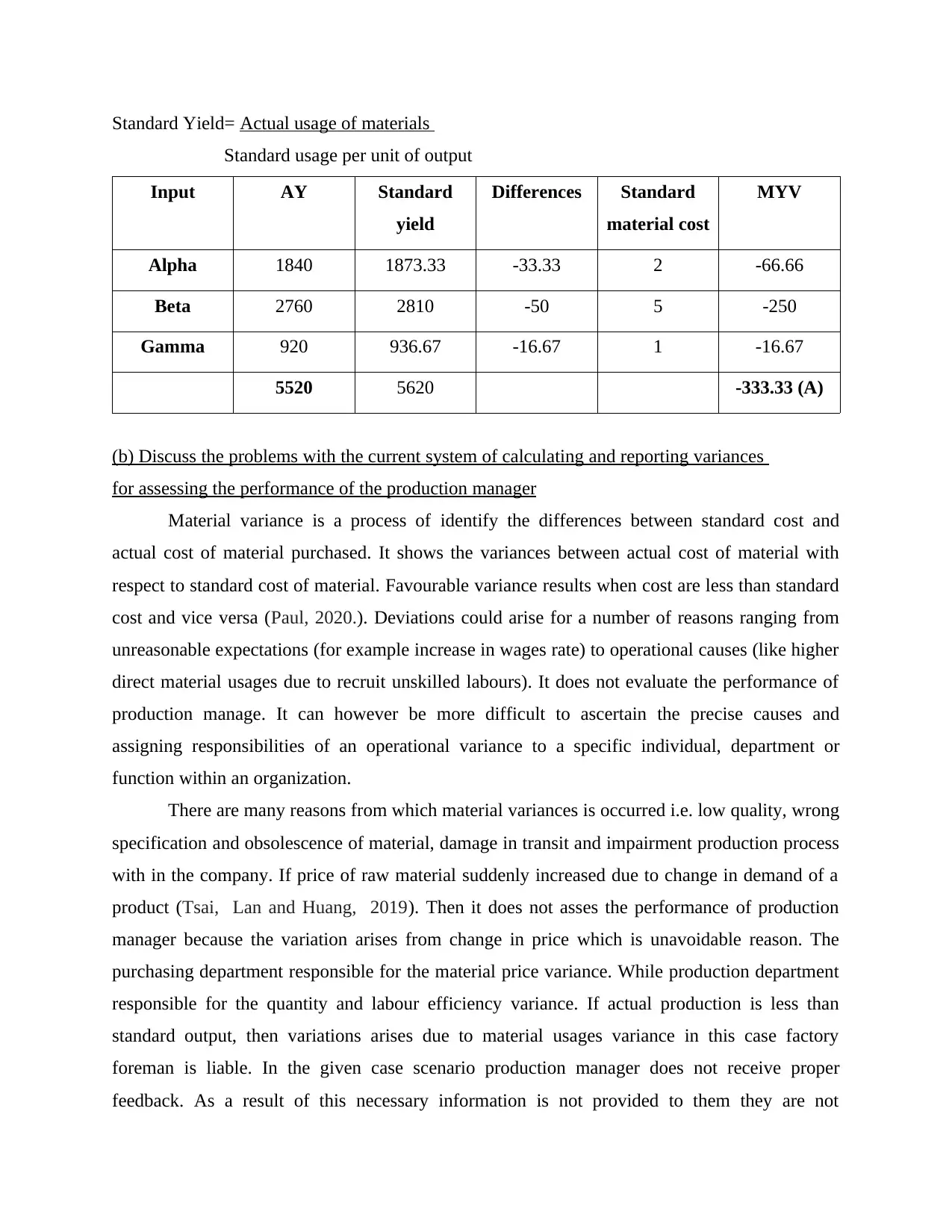
Standard Yield= Actual usage of materials
Standard usage per unit of output
Input AY Standard
yield
Differences Standard
material cost
MYV
Alpha 1840 1873.33 -33.33 2 -66.66
Beta 2760 2810 -50 5 -250
Gamma 920 936.67 -16.67 1 -16.67
5520 5620 -333.33 (A)
(b) Discuss the problems with the current system of calculating and reporting variances
for assessing the performance of the production manager
Material variance is a process of identify the differences between standard cost and
actual cost of material purchased. It shows the variances between actual cost of material with
respect to standard cost of material. Favourable variance results when cost are less than standard
cost and vice versa (Paul, 2020.). Deviations could arise for a number of reasons ranging from
unreasonable expectations (for example increase in wages rate) to operational causes (like higher
direct material usages due to recruit unskilled labours). It does not evaluate the performance of
production manage. It can however be more difficult to ascertain the precise causes and
assigning responsibilities of an operational variance to a specific individual, department or
function within an organization.
There are many reasons from which material variances is occurred i.e. low quality, wrong
specification and obsolescence of material, damage in transit and impairment production process
with in the company. If price of raw material suddenly increased due to change in demand of a
product (Tsai, Lan and Huang, 2019). Then it does not asses the performance of production
manager because the variation arises from change in price which is unavoidable reason. The
purchasing department responsible for the material price variance. While production department
responsible for the quantity and labour efficiency variance. If actual production is less than
standard output, then variations arises due to material usages variance in this case factory
foreman is liable. In the given case scenario production manager does not receive proper
feedback. As a result of this necessary information is not provided to them they are not
Standard usage per unit of output
Input AY Standard
yield
Differences Standard
material cost
MYV
Alpha 1840 1873.33 -33.33 2 -66.66
Beta 2760 2810 -50 5 -250
Gamma 920 936.67 -16.67 1 -16.67
5520 5620 -333.33 (A)
(b) Discuss the problems with the current system of calculating and reporting variances
for assessing the performance of the production manager
Material variance is a process of identify the differences between standard cost and
actual cost of material purchased. It shows the variances between actual cost of material with
respect to standard cost of material. Favourable variance results when cost are less than standard
cost and vice versa (Paul, 2020.). Deviations could arise for a number of reasons ranging from
unreasonable expectations (for example increase in wages rate) to operational causes (like higher
direct material usages due to recruit unskilled labours). It does not evaluate the performance of
production manage. It can however be more difficult to ascertain the precise causes and
assigning responsibilities of an operational variance to a specific individual, department or
function within an organization.
There are many reasons from which material variances is occurred i.e. low quality, wrong
specification and obsolescence of material, damage in transit and impairment production process
with in the company. If price of raw material suddenly increased due to change in demand of a
product (Tsai, Lan and Huang, 2019). Then it does not asses the performance of production
manager because the variation arises from change in price which is unavoidable reason. The
purchasing department responsible for the material price variance. While production department
responsible for the quantity and labour efficiency variance. If actual production is less than
standard output, then variations arises due to material usages variance in this case factory
foreman is liable. In the given case scenario production manager does not receive proper
feedback. As a result of this necessary information is not provided to them they are not
⊘ This is a preview!⊘
Do you want full access?
Subscribe today to unlock all pages.

Trusted by 1+ million students worldwide
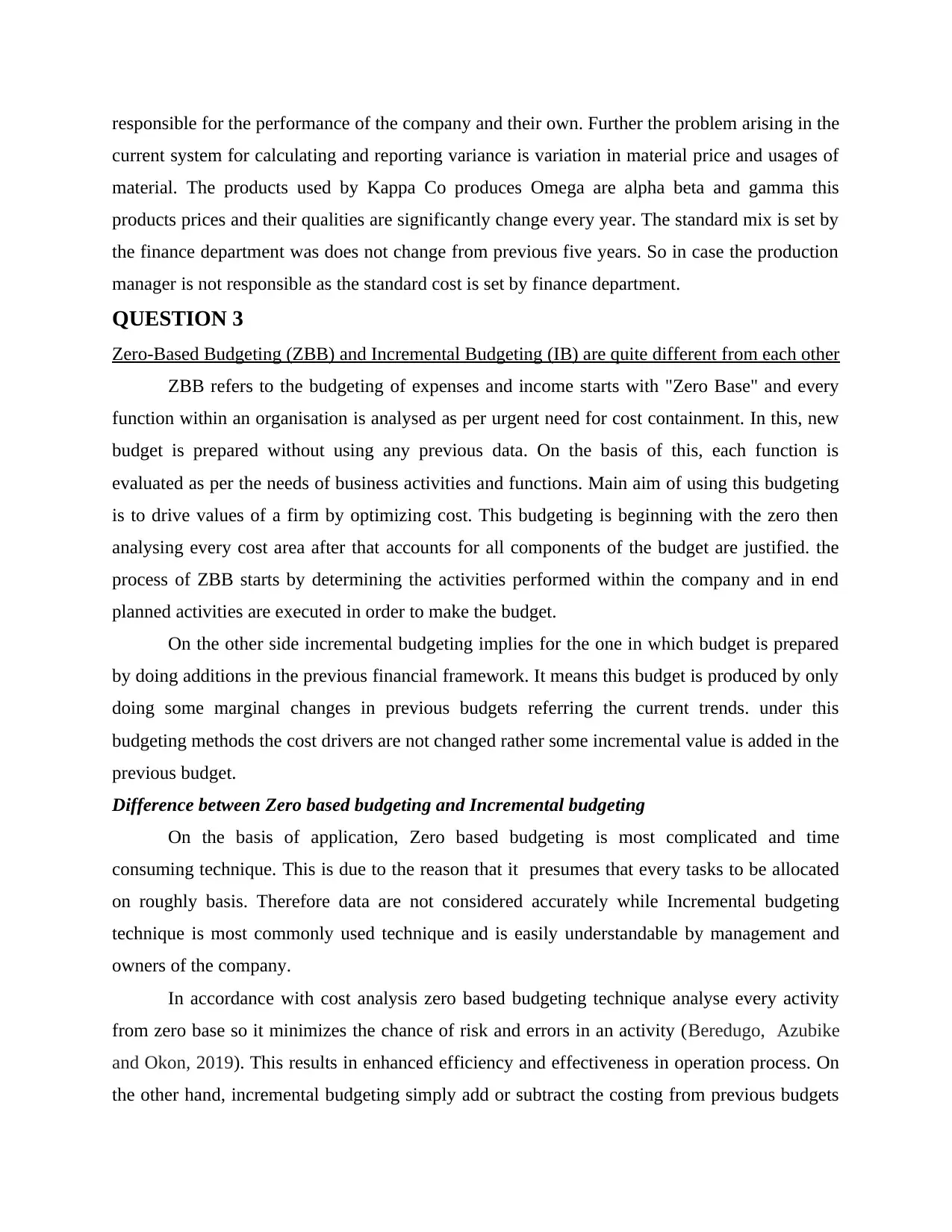
responsible for the performance of the company and their own. Further the problem arising in the
current system for calculating and reporting variance is variation in material price and usages of
material. The products used by Kappa Co produces Omega are alpha beta and gamma this
products prices and their qualities are significantly change every year. The standard mix is set by
the finance department was does not change from previous five years. So in case the production
manager is not responsible as the standard cost is set by finance department.
QUESTION 3
Zero-Based Budgeting (ZBB) and Incremental Budgeting (IB) are quite different from each other
ZBB refers to the budgeting of expenses and income starts with "Zero Base" and every
function within an organisation is analysed as per urgent need for cost containment. In this, new
budget is prepared without using any previous data. On the basis of this, each function is
evaluated as per the needs of business activities and functions. Main aim of using this budgeting
is to drive values of a firm by optimizing cost. This budgeting is beginning with the zero then
analysing every cost area after that accounts for all components of the budget are justified. the
process of ZBB starts by determining the activities performed within the company and in end
planned activities are executed in order to make the budget.
On the other side incremental budgeting implies for the one in which budget is prepared
by doing additions in the previous financial framework. It means this budget is produced by only
doing some marginal changes in previous budgets referring the current trends. under this
budgeting methods the cost drivers are not changed rather some incremental value is added in the
previous budget.
Difference between Zero based budgeting and Incremental budgeting
On the basis of application, Zero based budgeting is most complicated and time
consuming technique. This is due to the reason that it presumes that every tasks to be allocated
on roughly basis. Therefore data are not considered accurately while Incremental budgeting
technique is most commonly used technique and is easily understandable by management and
owners of the company.
In accordance with cost analysis zero based budgeting technique analyse every activity
from zero base so it minimizes the chance of risk and errors in an activity (Beredugo, Azubike
and Okon, 2019). This results in enhanced efficiency and effectiveness in operation process. On
the other hand, incremental budgeting simply add or subtract the costing from previous budgets
current system for calculating and reporting variance is variation in material price and usages of
material. The products used by Kappa Co produces Omega are alpha beta and gamma this
products prices and their qualities are significantly change every year. The standard mix is set by
the finance department was does not change from previous five years. So in case the production
manager is not responsible as the standard cost is set by finance department.
QUESTION 3
Zero-Based Budgeting (ZBB) and Incremental Budgeting (IB) are quite different from each other
ZBB refers to the budgeting of expenses and income starts with "Zero Base" and every
function within an organisation is analysed as per urgent need for cost containment. In this, new
budget is prepared without using any previous data. On the basis of this, each function is
evaluated as per the needs of business activities and functions. Main aim of using this budgeting
is to drive values of a firm by optimizing cost. This budgeting is beginning with the zero then
analysing every cost area after that accounts for all components of the budget are justified. the
process of ZBB starts by determining the activities performed within the company and in end
planned activities are executed in order to make the budget.
On the other side incremental budgeting implies for the one in which budget is prepared
by doing additions in the previous financial framework. It means this budget is produced by only
doing some marginal changes in previous budgets referring the current trends. under this
budgeting methods the cost drivers are not changed rather some incremental value is added in the
previous budget.
Difference between Zero based budgeting and Incremental budgeting
On the basis of application, Zero based budgeting is most complicated and time
consuming technique. This is due to the reason that it presumes that every tasks to be allocated
on roughly basis. Therefore data are not considered accurately while Incremental budgeting
technique is most commonly used technique and is easily understandable by management and
owners of the company.
In accordance with cost analysis zero based budgeting technique analyse every activity
from zero base so it minimizes the chance of risk and errors in an activity (Beredugo, Azubike
and Okon, 2019). This results in enhanced efficiency and effectiveness in operation process. On
the other hand, incremental budgeting simply add or subtract the costing from previous budgets
Paraphrase This Document
Need a fresh take? Get an instant paraphrase of this document with our AI Paraphraser
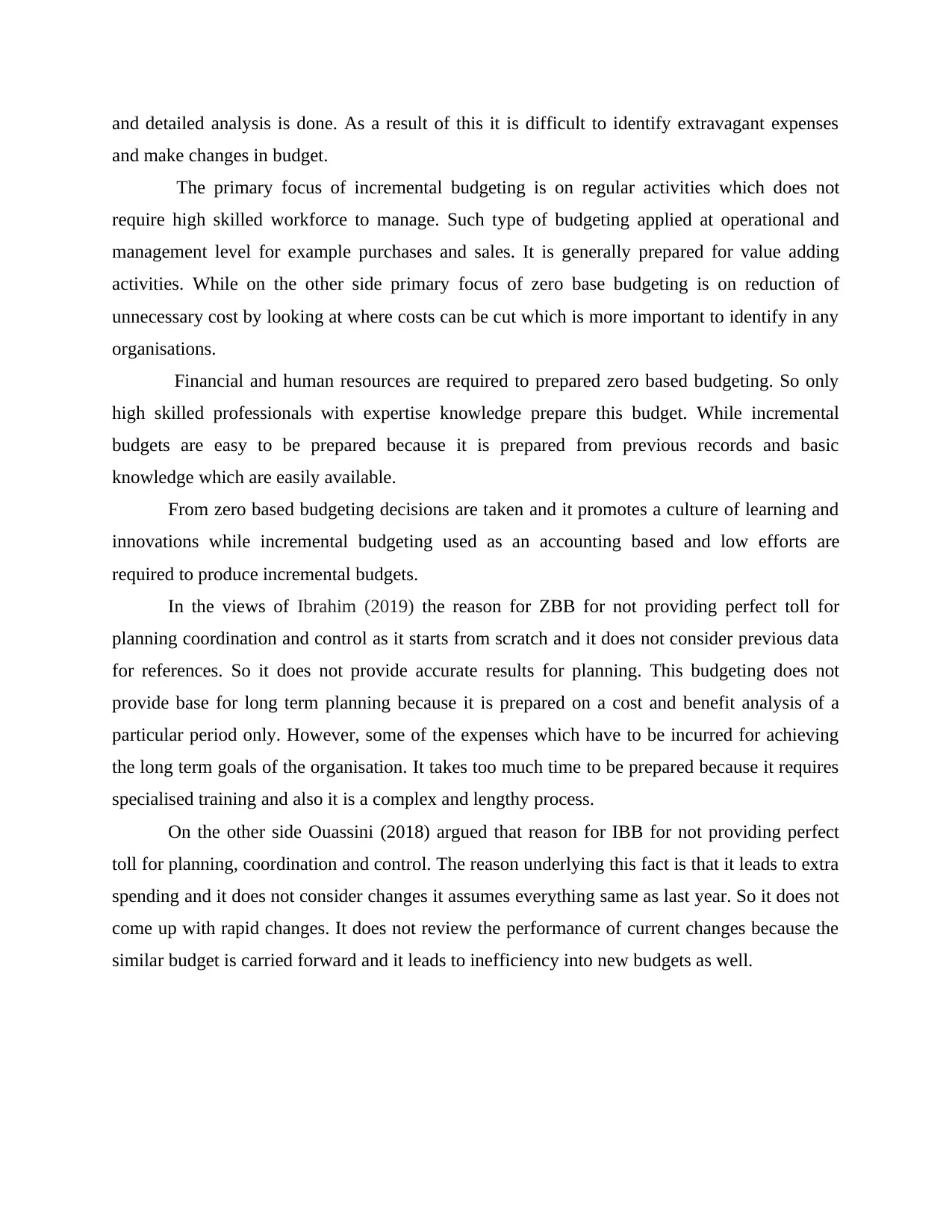
and detailed analysis is done. As a result of this it is difficult to identify extravagant expenses
and make changes in budget.
The primary focus of incremental budgeting is on regular activities which does not
require high skilled workforce to manage. Such type of budgeting applied at operational and
management level for example purchases and sales. It is generally prepared for value adding
activities. While on the other side primary focus of zero base budgeting is on reduction of
unnecessary cost by looking at where costs can be cut which is more important to identify in any
organisations.
Financial and human resources are required to prepared zero based budgeting. So only
high skilled professionals with expertise knowledge prepare this budget. While incremental
budgets are easy to be prepared because it is prepared from previous records and basic
knowledge which are easily available.
From zero based budgeting decisions are taken and it promotes a culture of learning and
innovations while incremental budgeting used as an accounting based and low efforts are
required to produce incremental budgets.
In the views of Ibrahim (2019) the reason for ZBB for not providing perfect toll for
planning coordination and control as it starts from scratch and it does not consider previous data
for references. So it does not provide accurate results for planning. This budgeting does not
provide base for long term planning because it is prepared on a cost and benefit analysis of a
particular period only. However, some of the expenses which have to be incurred for achieving
the long term goals of the organisation. It takes too much time to be prepared because it requires
specialised training and also it is a complex and lengthy process.
On the other side Ouassini (2018) argued that reason for IBB for not providing perfect
toll for planning, coordination and control. The reason underlying this fact is that it leads to extra
spending and it does not consider changes it assumes everything same as last year. So it does not
come up with rapid changes. It does not review the performance of current changes because the
similar budget is carried forward and it leads to inefficiency into new budgets as well.
and make changes in budget.
The primary focus of incremental budgeting is on regular activities which does not
require high skilled workforce to manage. Such type of budgeting applied at operational and
management level for example purchases and sales. It is generally prepared for value adding
activities. While on the other side primary focus of zero base budgeting is on reduction of
unnecessary cost by looking at where costs can be cut which is more important to identify in any
organisations.
Financial and human resources are required to prepared zero based budgeting. So only
high skilled professionals with expertise knowledge prepare this budget. While incremental
budgets are easy to be prepared because it is prepared from previous records and basic
knowledge which are easily available.
From zero based budgeting decisions are taken and it promotes a culture of learning and
innovations while incremental budgeting used as an accounting based and low efforts are
required to produce incremental budgets.
In the views of Ibrahim (2019) the reason for ZBB for not providing perfect toll for
planning coordination and control as it starts from scratch and it does not consider previous data
for references. So it does not provide accurate results for planning. This budgeting does not
provide base for long term planning because it is prepared on a cost and benefit analysis of a
particular period only. However, some of the expenses which have to be incurred for achieving
the long term goals of the organisation. It takes too much time to be prepared because it requires
specialised training and also it is a complex and lengthy process.
On the other side Ouassini (2018) argued that reason for IBB for not providing perfect
toll for planning, coordination and control. The reason underlying this fact is that it leads to extra
spending and it does not consider changes it assumes everything same as last year. So it does not
come up with rapid changes. It does not review the performance of current changes because the
similar budget is carried forward and it leads to inefficiency into new budgets as well.

⊘ This is a preview!⊘
Do you want full access?
Subscribe today to unlock all pages.

Trusted by 1+ million students worldwide
1 out of 14
Related Documents
Your All-in-One AI-Powered Toolkit for Academic Success.
+13062052269
info@desklib.com
Available 24*7 on WhatsApp / Email
![[object Object]](/_next/static/media/star-bottom.7253800d.svg)
Unlock your academic potential
Copyright © 2020–2025 A2Z Services. All Rights Reserved. Developed and managed by ZUCOL.





